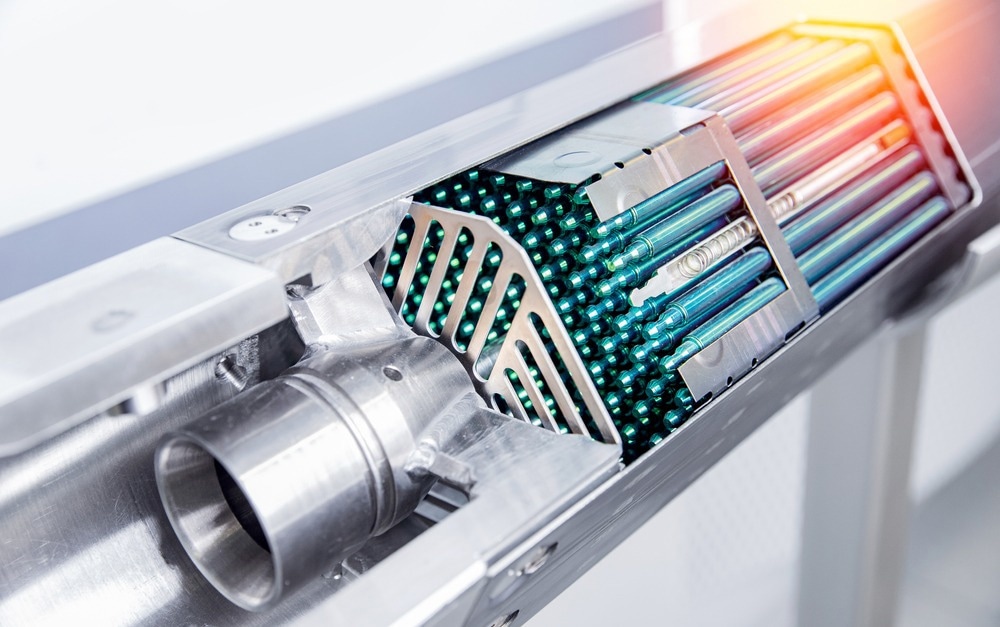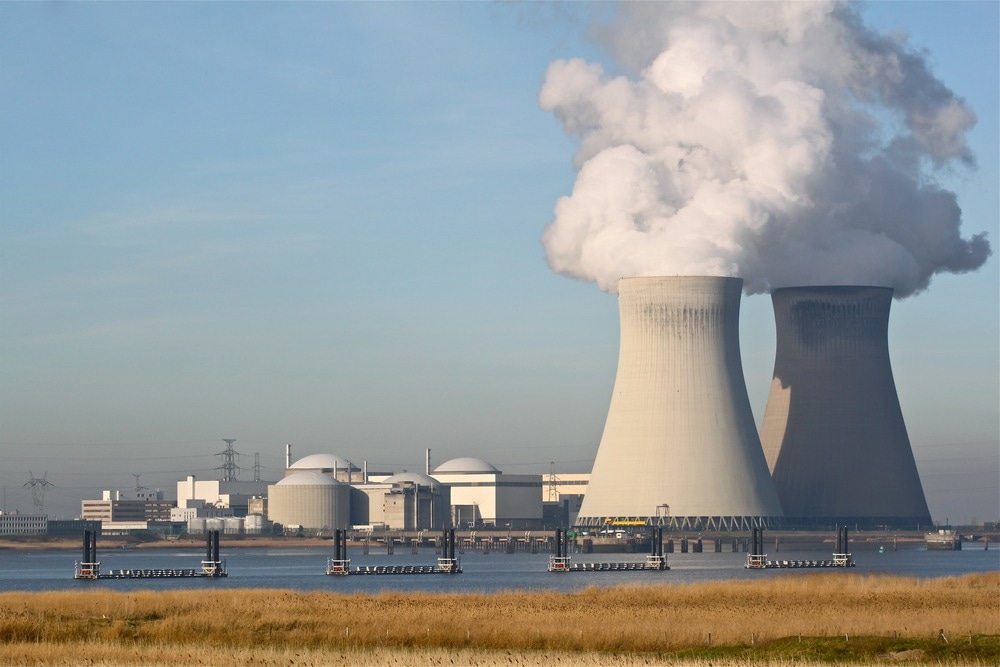A nuclear reactor is a device that generates heat through a controlled release of energy from splitting the atoms of certain elements. In nuclear power plants, the heat produces steam, which drives turbogenerators to generate electricity. This article describes the main component of a nuclear reactor and the basics of its operation.

Image Credit: Parilov/Shutterstock.com
Over the past 70 years, several different types of reactors have been developed for electricity generation. The principles behind nuclear power generation are quite similar for most reactor types. The energy released from a continuously controlled fission reaction in the reactor fuel is converted to heat by either gas or a liquid coolant and is used to produce steam. Similarly to most fossil fuel power plants, steam drives turbines and generators that produce electricity.
Containment Structure
The structure surrounding the reactor and its auxiliary components (such as steam generators and pumps) is designed to protect the reactor from outside intrusion and to prevent the release of radioactive materials in the event of an accident. The containment is typically made of high-strength reinforced concrete and steel and is designed to withstand extreme conditions, such as a loss of coolant or a release of pressure. Newer reactor designs also feature core-melt localization devices under the reactor's pressure vessel to contain any melted core material in the event of a major accident.
Fuel for Nuclear Reactors
The fuel in a nuclear reactor consists of uranium oxide (UO2) pellets assembled into fuel rods. Natural uranium consists of 0.7% uranium 235 and 99.2% uranium 238. In most commercial power-generating reactors, the fuel is enriched in uranium 235 (to approximately 3.5-5.0% overall content), which is an isotope that can easily sustain a fission chain reaction. Some nuclear reactors (depending on the moderator) use natural uranium as fuel. In a large gigawatt-class reactor, there can be several hundred fuel rods with tens of thousands of pellets. The fuel rods are arranged in the core of the reactor in a pattern that maximizes the heat exchange between the fuel and the coolant.
Moderator Materials
In a nuclear reactor, colliding neutrons initiate the fission reaction of the uranium nuclei. The collision releases secondary particles and several high-energy neutrons, thus sustaining the nuclear chain reaction.
The neutrons from uranium 235 have kinetic energy on the order of a few MeV (so-called fast neutrons). As they propagate within the reactor, they collide with other atoms and scatter, thus losing energy and becoming thermal neutrons with energy of the order of a few meV. The energy of the neutrons determines how they interact with the atoms of the nuclear fuel. The moderator material in the reactor core slows down the neutrons released from the fission reaction so that they can collide with more atoms and sustain the chain reaction. In most commercial reactors, the moderator is water, which also acts as a coolant or graphite. In some cases, heavy water (deuterium oxide) is used as a moderator/coolant.
Chain Reaction Control
Control rods serve as regulators of the reaction in the reactor. They are made of neutron-absorbing materials, such as cadmium, hafnium, or boron, and can be inserted or withdrawn from the core to control the chain reaction rate or to halt the reaction altogether. In some reactor designs, special control rods are introduced to enable stable and efficient reactor operation at lower power. Most reactor designs feature a secondary reaction control system that involves neutron absorbers, such as boric acid, mixed with the coolant. The concentration of such neutron absorbers is adjusted over time as the fuel gets depleted.
Coolant and Heat Transfer Systems
In most commercial reactor designs, a strong steel vessel contains the reactor core and moderator/coolant. The coolant fluid (which can be liquid or gas) that circulates through the reactor core transfers the generated heat to a steam generator, where it produces steam. In light water reactors, the water serves as a primary coolant and moderator at the same time.

Image Credit: BeAvPhoto/Shutterstock.com
Depending on the reactor type, usually, there is a secondary coolant circuit that separates the core coolant (that is radioactive) from the steam-generating circuit. (See also a later section on primary coolant characteristics.) The primary coolant circuit usually consists of several independent loops with dedicated pumps for redundancy. Water is the most common coolant, although other fluids, such as helium or molten sodium, can also be used.
Main Types of Nuclear Reactors
Currently, the most widely used design is the pressurized water reactor. The type of reactor was originally designed as a nuclear submarine power plant. The water, circulating through the reactor core and in the primary cooling/heat transfer circuit at a pressure of 150 bar, is heated to 325°C and generates steam in a secondary circuit.
The less numerous boiling water reactors produce steam in the primary circuit within the reactor core at similar temperatures and pressure. Both reactor types employ water as a coolant and moderator.
Pressurized heavy water reactors use natural uranium (0.7% uranium 235) oxide as fuel and heavy water as a moderator. This type of reactor generates more energy per kilogram of uranium fuel compared to light water reactors but also produces more spent fuel per unit output energy.
Fast neutron reactors do not require moderator material to operate and utilize fast neutrons that can initiate a fission reaction in plutonium while producing more plutonium fuel from the uranium 238 isotope present in or around the fuel. These reactors can produce 60 times more energy from the same amount of uranium material compared with moderated reactors. However, they are very expensive to build. Further development of this type of reactor is a key challenge for the next decade, as it can produce more fresh plutonium fuel than they consume during its operation in the so-called fast breeder reactor configuration.
More from AZoM: Gallium Nitride Semiconductors in 5G Networks
References and Further Reading
Okunev, V. S. (2019) Designing of new generation of the nuclear reactors. AIP Conference Proceedings 2195, 020012. Available at: https://doi.org/10.1063/1.5140112
Nathan, J. A., Singh, V. A. (2016) The design of a nuclear reactor. Reson 21, 843–856. Available at: https://doi.org/10.1007/s12045-016-0389-2
Suppes, G. J, Storvick, T. S. (2007) Nuclear Power Plant Design, Editor(s): Galen J. Suppes, Truman S. Storvick, In Sustainable World, Sustainable Nuclear Power, Academic Press, pages 319-351. Available at: https://doi.org/10.1016/B978-012370602-7/50029-6
Disclaimer: The views expressed here are those of the author expressed in their private capacity and do not necessarily represent the views of AZoM.com Limited T/A AZoNetwork the owner and operator of this website. This disclaimer forms part of the Terms and conditions of use of this website.